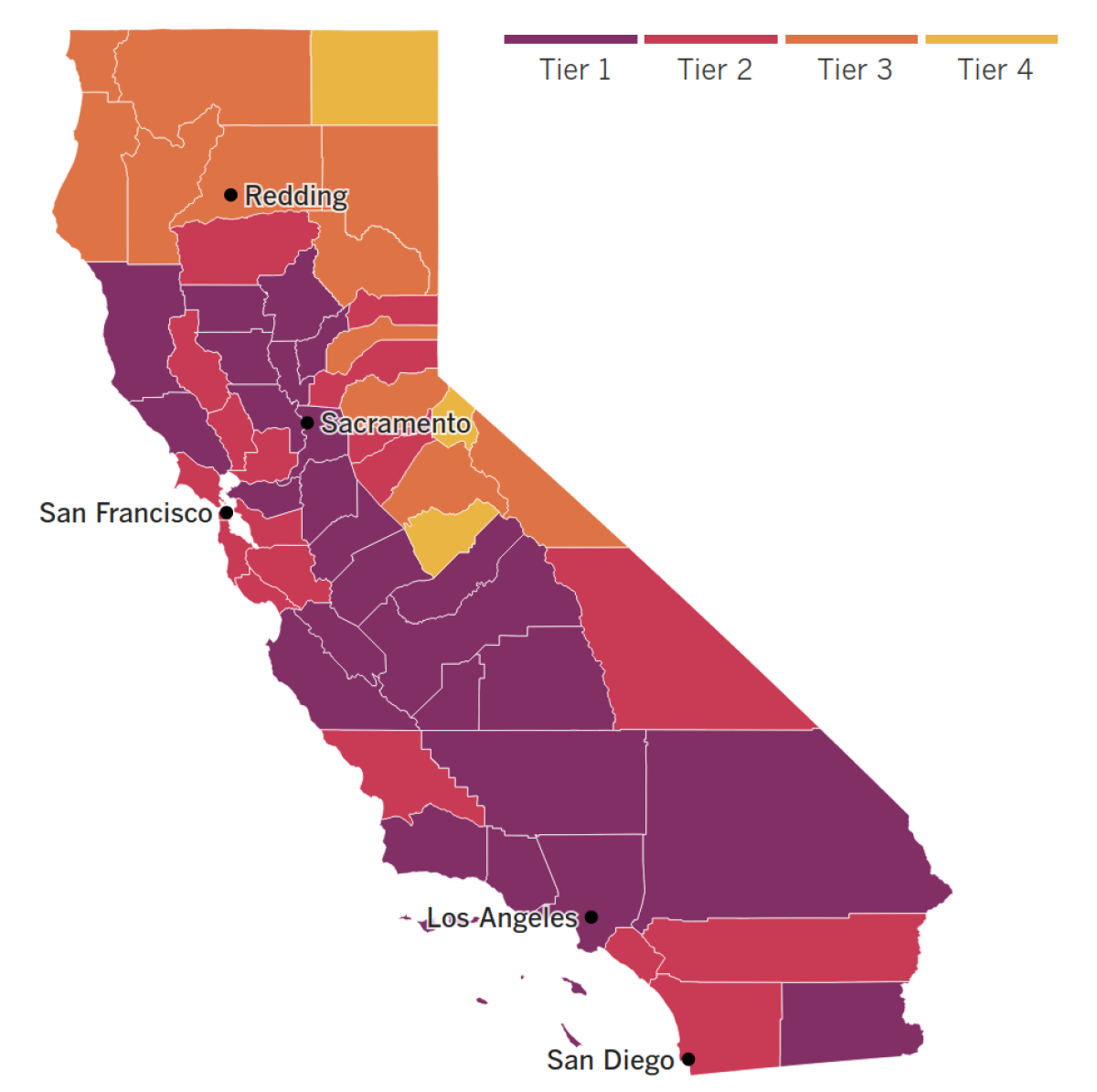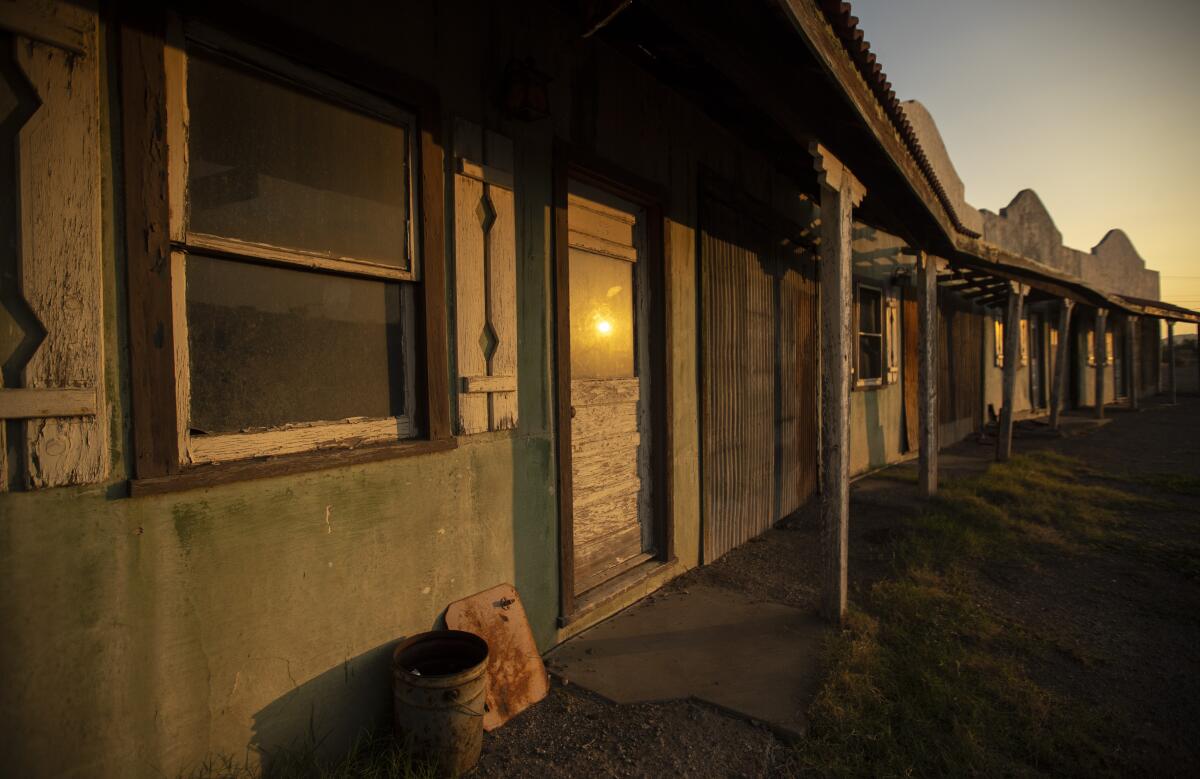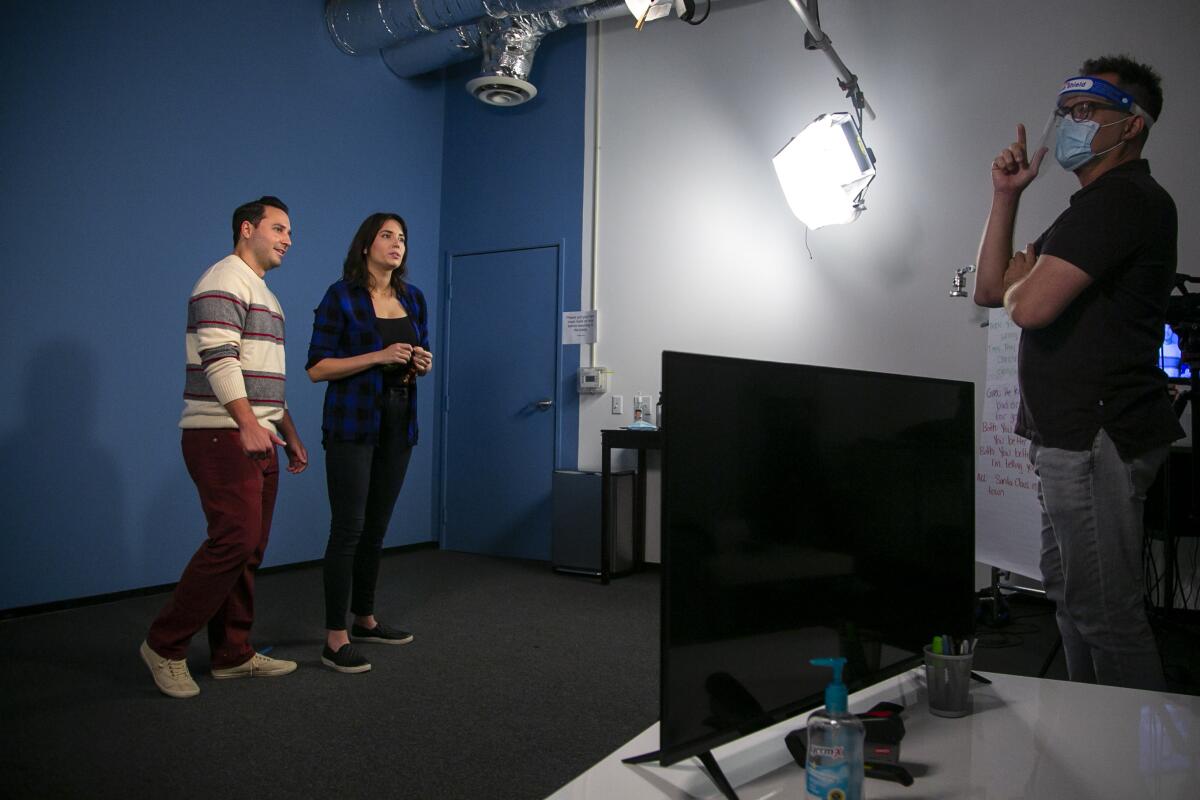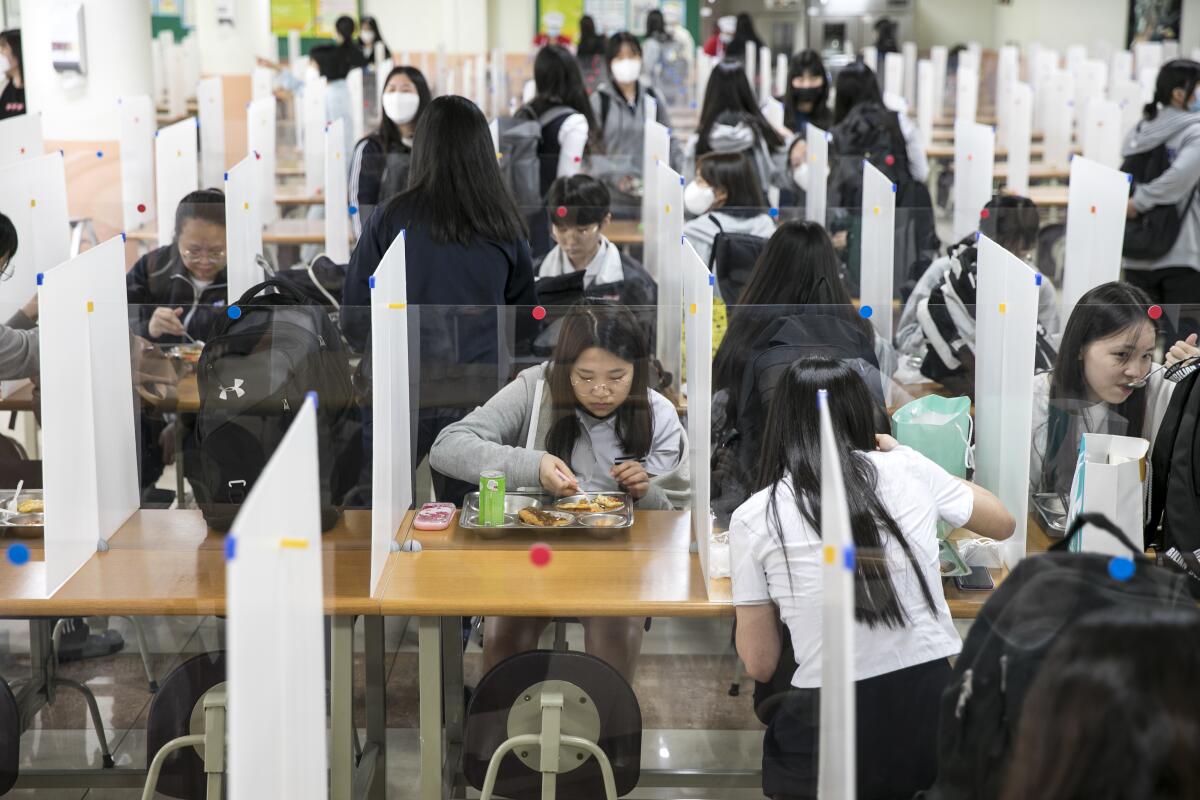Coronavirus Today: What does Florida think?
- Share via
Good evening. I’m Lila Seidman, and it’s Friday, Sept. 25. Here’s the latest on what’s happening with the coronavirus, plus ways to spend your weekend and a look at some of the week’s best stories.
Trump almost certainly needs Florida’s 29 electoral college votes to win reelection in November. Will his handling of the COVID-19 pandemic undermine his chances there?
Nearly 13,800 Floridians have lost their lives to the virus. The related collapse of tourism has wiped out more than 500,000 jobs in the state, according to the U.S. Bureau of Labor Statistics. It’s a senior-heavy state, and people in that age group are more vulnerable to the coronavirus, and more concerned about the pandemic.
Some voters, like 79-year-old Priscilla Skalka, are disappointed in Trump’s response. The self-described independent said she contracted the virus in June and spent six days fighting for her life in a hospital’s intensive care unit. “I’m still recuperating,” she said. “We’re here, almost in October, and I’m still not myself. It’s very scary.”
Not all voters see Trump’s response in the same light. Joseph Wieder, a retired construction worker and Marine veteran, says that when the pandemic hit, the president did “all that a man could possibly do to look out for the American people.”
In 2016, Trump defeated Hillary Clinton in the Sunshine State by a margin of just 1%. This time, polls give democratic challenger Joe Biden a slight edge, though the most recent numbers suggest Trump may be in the midst of a rebound.
Both campaigns are spending exorbitant sums in the hopes of winning the most populous battleground state. Since August, Biden and his allies have spent $39 million on Florida ads, many of them attacking Trump on the pandemic. Trump and his backers have spent $26 million on ads themselves, including some stressing economic recovery and the progress toward a vaccine.
“It’s really kind of a serious issue for a lot of people,” said one Democratic pollster in Florida. “They just want to live.”
By the numbers
California cases and deaths as of 4:33 p.m. PDT Friday:

Track the latest numbers and how they break down in California with our graphics.
See the current status of California’s reopening, county by county, with our tracker.


What to read this weekend
In the windswept crossroads of Lordsburg, N.M., the shuttered school has turned into a food bank. The museum has closed altogether. And with interstate traffic down during the pandemic, hardly anybody stops anymore in this town that relies on taxes for gas and lodging. As towns nationwide hemorrhage cash and states slash funding that would normally trickle down to them, the virus’s toll has upended budgets, forced evictions and cost the jobs of people like Dean Link, who used to be the museum’s sole employee. “So much history lost in these historic times,” he said.

“When the pandemic hit, I lost my job as a touring musician. And in losing that job, I lost my primary income stream,” says Emma Swift. So she turned to Bandcamp, a streaming platform whose business model and transparent approach to royalties have helped it thrive at a moment of huge challenges for musicians. Starved of road money and feeling abused by services like Spotify that pay just fractions of a penny per spin, artists have flocked to Bandcamp, and fans have followed. There, the connection between musician and fan is virtually direct — essential in the time of the coronavirus.
As Hollywood productions resume, actors and casting directors are navigating a whole new world for auditions — socially distanced studio layouts, elaborate self-tape setups and awkward Zoom meetings. Actors who interact physically must be quarantining with each other, leading to an uptick in casting calls for real-life couples and family members. “It’s interesting because before the pandemic, we would get an audition together maybe, like, once a month?” according to one-half of an actor couple. “And now we’re getting them way more than we’re getting individuals.”

The holiest period on the Jewish calendar is coinciding with Israel’s reimposition of coronavirus lockdown as it experiences a second wave of infections. With Yom Kippur arriving Sunday evening, political and religious leaders are now locked in a fierce debate over if and how synagogues should remain open. “Every effort must be made to pray on Yom Kippur,” a respected cantor said. “But anyone who doesn’t keep to the [coronavirus] restrictions is a social criminal.”
Even before the pandemic, food delivery apps were reshaping the restaurant industry, and L.A. was becoming an epicenter of the booming economy of “ghost kitchens.” Add in the coronavirus, and the trend looks like it’s here for good. The increasingly popular commercial kitchens exist solely to fulfill online orders, with no brick-and-mortar restaurants attached. Equipped with reams of data provided by app users, tech-based delivery companies can home in on demand, even pitching branded concepts to struggling businesses. “It’s the same way that Amazon and Netflix operate,” an expert says. So how do individual restaurant owners fare? That’s more complicated.
Your support helps us deliver the news that matters most.
What to do this weekend
Get a flu shot. Health experts say it’s more important than ever to protect yourself against the flu and reduce the chances of a “twindemic.” California could see COVID-19 hospitalizations rise by 89% over the next month, the state’s top health official said Friday. That alone wouldn’t put hospitals near their capacity, but it wouldn’t leave much room for flu patients, he said. Here’s what you need to know to find a flu shot in Southern California, including some free options.
Get outside. This Saturday, you can visit national parks for free. Want to keep a closer eye on civilization? Take this self-guided Pasadena architectural tour in the pandemic-friendly privacy of your car, or head further afield for one of these seven Southern California day trips that are heavy on the outdoors and wildlife — from the sea lions of La Jolla Cove to the Living Desert Zoo in Palm Desert. Get more California travel ideas in our Escapes newsletter.
Watch something great. Our weekend culture watch list includes the L.A. Philharmonic’s pandemic concert series, the musical “Fame” and comic Maria Bamford’s show, plus 17 other options. And in his Indie Focus newsletter’s roundup of new movies, Mark Olsen details three new films about tender oddballs, would-be revolutionaries and more.
Eat something great. Now that we’ve all raided our cabinets during the pandemic, it’s time garlic powder got its due, writes cooking columnist Ben Mims. He offers some recipes to prove it and some advice on the best brands. If you’re observing Yom Kippur this weekend, consult our high holiday recipes for a way to break the fast — like this caramelized fig cake with lemon anglaise.
Go online. Here’s The Times’ guide to the internet for when you’re looking for information on self-care, feel like learning something new or interesting, or want to expand your entertainment horizons.
Resources
— For general safety, wash your hands for at least 20 seconds (here’s a super-fun how-to video). Stop touching your face, and keep your phone clean. Practice social distancing, maintaining a six-foot radius of personal space in public. And wear a mask if you leave home. Here’s how to do it right.
— Watch for symptoms including fever, cough, shortness of breath, chills, repeated shaking with chills, muscle pain, headache, sore throat and loss of taste or smell. If you’re worried you might be infected, call your doctor or urgent care clinic before going there.
— Need a COVID-19 test? Here’s how to receive a free test if you’re in L.A. County. And here’s a map of testing sites across California.
— Here’s how to care for someone with COVID-19, from monitoring their symptoms to preventing the virus’ spread.
— If your job has been affected by the pandemic, here’s how to file for unemployment.
— Here are some free resources for restaurant workers and entertainment industry professionals having trouble making ends meet.
— Advice for helping kids navigate pandemic life includes being honest about uncertainties, acknowledging their feelings and sticking to a routine. Here’s guidance from the CDC.
— In need of mental health services? Here are resources for coping during the crisis from the CDC and the L.A. County Department of Mental Health. L.A. County residents can also call (800) 854-7771 or text “LA” to 741741.
— For domestic violence victims, the pandemic can pose a “worst-case scenario,” advocates say. If you or someone you know is experiencing such abuse, call the National Domestic Violence Hotline at 1-800-799-SAFE (7233) or L.A. County’s hotline at 1-800-978-3600. Here are more ways to get help.The pandemic in pictures

South Korea briefly tried reopening schools in May, then shut them temporarily due to a spike in coronavirus cases. They’ve since reduced class sizes, installed plastic barriers to separate students during lunch and begun requiring more handwashing and temperature checks. In general, overall increases in cases since then have been tied to a club, a church and a rally — not schools.
With schools in Orange County and San Diego County bringing students back to campus, we took a look at how schools around the world are handling their reopenings. You can read more about other countries’ approaches here.
Our reporters covering the coronavirus outbreak want to hear from you. Email us your questions, and we’ll do our best to answer them. You can find more answers in our Frequently Asked Questions roundup and in our reopening tracker.
For the most up-to-date coronavirus coverage from The Times over the weekend, visit our homepage and our Health section, sign up for our breaking news alerts, and follow us on Twitter and on Instagram.




